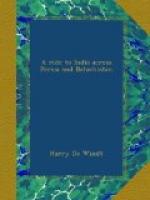My favourite walk, after the heat of the day, was to the little cemetery where Hafiz, the Persian poet, lies at rest—a quiet, secluded spot, on the side of a hill, in a clump of dark cypress trees a gap cut through which shows the drab-coloured city, with its white minarets and gilt domes shining in the sun half a mile away. The tomb, a huge block of solid marble, brought across the desert from Yezd, is covered with inscriptions—the titles of the poet’s most celebrated works. Near it is a brick building containing chambers, where bodies are put for a year or so previous to final interment at Kermanshah or Koom. Each corpse was in a separate room—a plain whitewashed compartment, with a square brick edifice in the centre containing the body. Some of the catafalques were spread with white table-cloths, flowers, candles, fruit, and biscuits, which the friends and relations (mostly women and children) of the defunct were discussing in anything but a mournful manner. A visit to a departed one’s grave is generally an excuse for a picnic in Persia.
Hard by the tomb of Hafiz is a garden, one of many of the kind around Shiraz. It is called “The Garden of the Seven Sleepers,” and is much frequented in summer by Shirazis of both sexes. A small open kiosk, in shape something like a theatre proscenium, stands in the centre, its outside walls completely hidden by rose and jasmine bushes. Inside all is gold moulding, light blue, green, and vermilion. A dome of looking-glass reflects the tesselated floor. Strangely enough, this garish mixture of colour does not offend the eye, toned down as it is by the everlasting twilight shed over the mimic palace and garden by overhanging branches of cypress and yew. An expanse of smooth-shaven lawn, white beds of lily and narcissus, marble tanks bubbling over with clear, cold water, and gravelled paths winding in and out of the trees to where, a hundred yards or so distant, a sunk fence divides the garden from a piece of ground two or three acres in extent,—a perfect jungle of trees, shrubs, and flowers.




